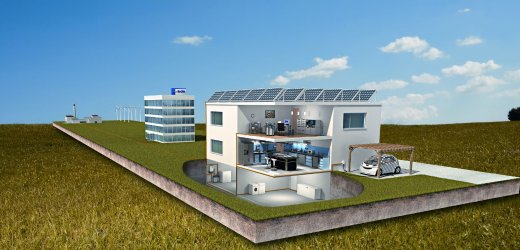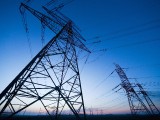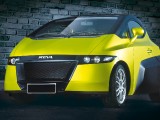 Decentralizing electricityOct 14, 2009 - Stefan Schultz - Spiegel Online Part1: The Coming Energy Revolution
The power grid of the future is one of humanity's boldest visions. Gigantic wind farms in the sea and enormous solar fields in the desert are to generate the bulk of our power in the years to come. But consumers and companies are also producing energy with mini-power plants in their own basements and solar panels on the roof. And intelligent appliances are saving energy in our homes: washers, dryers and refrigerators that communicate with each other wash, dry or cool when electricity is cheapest. The information age is arriving at a new level: It's becoming the electricity age.
Together with firms like Siemens, SAP, IBM and energy giants like EnBW, RWE and Vattenfall, Germany's economics and environment ministries have already mobilized €140 million for the development of the associated technologies and the tests. The government has provided €60 million and the industrial partners are raising the rest together with public utilities and smaller, innovative technology partners. According to Ludwig Karg, one of the researchers working together with scientists and communication experts in the model regions, E-Energy is intended to jump-start a greater energy revolution in Germany. "We are providing German companies with future access to markets worth billions," he said. Companies Create New Super Sector The project actually does have the potential to speed things up. It could help to explain the new technologies to consumers. Indeed, a number of recent developments suggest the energy revolution is already taking shape. In recent months, numerous spectacular future-oriented projects have been launched:
The upheaval these projects have the potential to cause is enormous: Energy and IT markets are drawing closer together and the automobile industry will likely follow soon. A new super sector could change the competitive landscape and create new opportunities for partnerships. It will open up new business opportunities for the beleaguered automobile sector, power and IT companies as well as innovative start-ups, providing vast growth opportunities. 'The Greatest Infrastructure Project of the Decade' Consumers could also stand to benefit from the transformation of the energy market. The German government estimates that more efficient power supply management could save 10 terawatt-hours (i.e. a billion kWh) of energy a year, which corresponds to the annual consumption of 2.5 million households. Márta Nagy-Rotherngass, head of the European Commission's Information and Communication Technologies for Sustainable Growth unit, says the modernization of the energy grid is a "win win situation" for everyone. Industry experts are urging Germany to spearhead this future market and to try to create an export success story with the technologies that are being tested. E-Energy expert Karg, who introduced the project late last month at a conference in Washington, said the Americans were keen to work together intensively with German companies on the modernization of the power grid. But there is plenty of competition: The International Energy Agency expects to see investments of several billion dollars worldwide by 2030 in projects to generate electricity, manage consumption and modernize power grids. "The change in energy will be the greatest infrastructure project of the next decade," said Christian Feisst, head of business development at Cisco's SmartGrid subsidiary. In China there is a huge need for a smart electricity grid and the government is working hard to lay the technological foundations for it. The Americans are also investing heavily in future-oriented projects. Of the $39 billion that President Barack Obama has made available in his economic stimulus package for the promotion of green energies, more than $4 billion is expected to flow into the energy market. Dozens of US startups are producing hardware and software to enable consumers to monitor energy usage in real time, or to automatically regulate it. The German government and energy companies are generating plenty of headlines these days with projects like the giant wind farms in the North and Baltic seas, and the desert solar project Desertec. They are intended to massively increase green energy supplies. The Germany economics ministry has forecast that alternative energy sources could provide one-third of the country's electricity needs by 2030. But the true environmental revolution will happen from the bottom up, through mini power stations in basements of private homes, that generate both heat and power, as well as solar panels that can cover the electricity needs of factories. In future, energy will be supplied from millions of networked mini power plants rather than from relatively few centralized sources. In early September, carmaker Volkswagen and utility company Lichtblick launched their first major offensive on the people power grid: The two companies intend to install up to 100,000 combined heat and power units (CHPs) in the basements of apartment buildings. They will initially be fired by natural gas, later on possibly by biogas. The basement power plants will heat the homes while simultaneously producing electricity and sending precise data to the companies. The companies believe the total investment in the project will come to €2 billion. 'Virtual Power Plants' Residents of the cities of Karlsruhe and Stuttgart, where a government pilot E-Energy project is being tested, are already experiencing what it is like to be part a smart grid. There, 200 homes and companies have been equipped with photovoltaic systems and CHPs or fuel cells. This model transforms the consumer into a producer who can make some money in the energy market. They are also testing a pricing model in which electricity rates depend on supply and demand. If the amount of available energy goes down, the rates go up correspondingly. Users can monitor the system on an Internet portal and generate energy whenever the price peaks, thereby also stabilizing the overall supply. Lichtblick executives call them "virtual power stations" that can, within minutes, be networked to form a virtual giant electricity producer that can quickly compensate when other electricity production facilities are disturbed -- for example if the wind suddenly slows and thousands of wind turbines begin turning more slowly. Currently, it is next to impossible for consumers to see how much electricity they are using day to day, but devices are being developed to make it easier for consumers to monitor their energy usage. Franz-Reinhard Habbel, spokesman for the German Association of Municipalities, speaks of a "black box" for homes. The smart grid would tell consumers how much electricity each appliance is using. And consumers will be able to do a lot more to determine at which prices they consume electricity. Customers will be able to cut their electricity bills, moreover, by pinpointing off-peak hours to run their energy-intensive machines. Software and hardware is currently being developed that would enable consumers to automatically shut off washing machines, dishwashers or refrigerators during price peaks. "The utility companies will lose control," predicts Scott Lang, head of the Silicon Valley-based Silver Spring Networks, whose firm sells electricity meters that can already calculate up-to-the-minute usage. In addition to smart meters, a number of other potential growth markets are being tested as part of the E-Energy project. German household appliance maker Miele, for example, is supplying hundreds of homes in the Ruhr region with intelligent washing machines that provide exact details about usage and can be either programmed or operated remotely to automatically turn on and do their work at times of the day when electricity is cheapest. Other companies are building adapters that can turn older machines on and off, based on energy prices. A household's smart devices would be controlled by so-called home management systems. In the city of Mannheim, also home to an E-Energy pilot project, companies like Papendorf Software Engineering are developing related hardware and software under the "Energy Butler" label. Energy Management and Storage This sort of energy management -- that can switch appliances on and off depending on the amount of energy available from wind farms and solar plants -- is the main prerequisite for a power grid running largely on renewable energies. Supply and demand have to be tightly controlled to keep the grid from crashing. Innovative energy storage systems are also intended for the system. Batteries up until now have proven too expensive and in some cases too inefficient for the task. Now scientists are looking into other ways of storing energy, and new concepts are being tested in the German port city of Cuxhafen. During peak times, the region is able to produce more than 80 percent of its needed electricity using wind turbines, but when the wind dies down, so does the capacity to supply electricity. "To make up for fluctuations," said project leader Wolfram Krause, "cold stores could be cooled more than needed or swimming pools overheated. If less electricity is available later, cooling and heating devices could be temporarily turned off until the energy buffer has been used up." Storage solutions could also play a special role in electric cars in the future. In one E-Energy project in Germany's Harz mountains region, they serve as reserve batteries from the regional power net. If electricity supplies are low, cars not in use can also feed energy back into the grid. If millions of small power stations are feeding the mains with a fluctuating quantity of electricity, and millions upon millions of terminal devices and home management systems are transmitting energy consumption data or receiving commands, the grid operators' systems could go haywire. The power transmission has to be continually adjusted at millisecond intervals. And it's a process that can only be achieved if it is highly automated. That's why setting up such an intelligent power grid, that can manage this mass of data across the country, is probably the biggest challenge of the new electric age. "The deployment of all modern energy technologies will rise or fall based on the construction of a communications network that can deal with mass amounts of real-time data and transport them using Internet Protocols," said Ingo Schönberg, the head Power Plus Communications (PPC), a company that is producing such technologies. "A smart grid is the backbone of the new infrastructure." It's also one of the most lucrative emerging business opportunities. The hitherto dominant energy giants are suddenly faced with new and formidable foes: technology groups keen on seizing control over energy supplies on the Internet. Siemens CEO Peter Löscher puts the volume of the smart grid market at €30 billion by the year 2014. In September, the company said it was planning to invest €6 billion in this area over that period. IT giant Cisco is also eyeing the market. "We are calculating a future annual market potential of $20 billion," said Cisco SmartGrid executive Christian Feisst. He believes that within 10 years the technology will be deployable on a mass scale. And PPC's Schönberg believes that smart grids will be available in some cities in the next few years and that they will be available to the masses by the middle of the next decade. He said the first aim must be to automate as many measuring and control processes as possible in order to reduce the increasing levels of complexity. Cisco is currently conducting pilot tests of smart grids, but the company said it would like to provide an entire region with intelligent electricity by mid-2010. As part of the government's E-Energy project, companies including Siemens, ABB and IBM are developing central system platforms that can collect all the data on decentralized energy production and consumption. The systems also calculate electricity prices based on fluctuations and pass this information back to consumers using broadband connections or by mobile radio. Together, these technologies will create an energy market place in which consumers themselves can buy and sell power. An El Dorado for Service Providers A market in which energy is traded according to supply and demand will provide immense opportunities for service providers and startups. Some are developing systems to predict rate fluctuations based on weather forecasts and behavioral statistics. Mobile software, e.g. iPhone-Apps, are likely to figure prominently in this sector. Resourceful start-ups can also come up with business innovations for an energy grid 2.0, e.g. setting up social networks to help and hone ecological householding. In the US, a new generation of startups is already sounding the clarion call to an ecological revolution on the Web. Web visionaries say the Internet has the potential to revolutionize the way we think about the environment: For one thing, it can expose waste and pollution, and pinpoint the culprits. That should give rise to a collective environmental conscience, forcing us to think more critically about how we use energy. |
Email this page to a friend
If you speak another language fluently and you liked this page, make
a contribution by translating
it! For additional translations check out FreeTranslation.com
(Voor vertaling van Engels tot Nederlands)
(For oversettelse fra Engelsk til Norsk)
(Для дополнительных
переводов проверяют
FreeTranslation.com )





